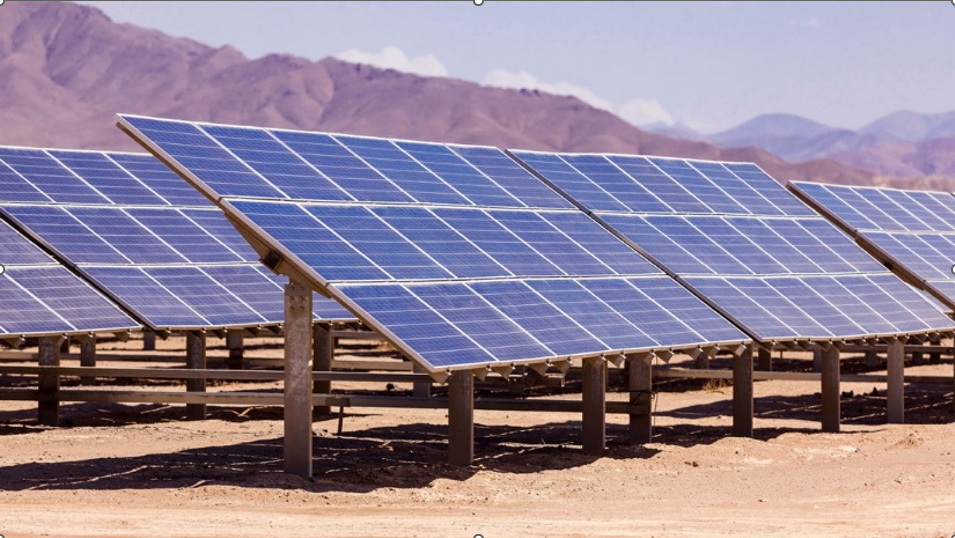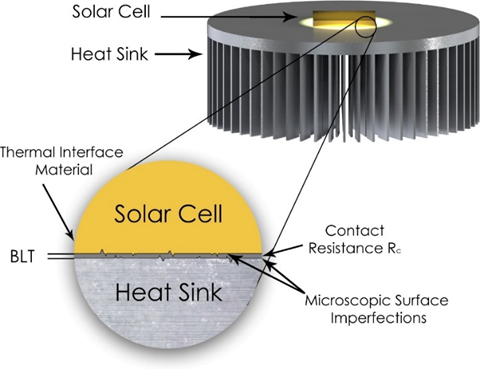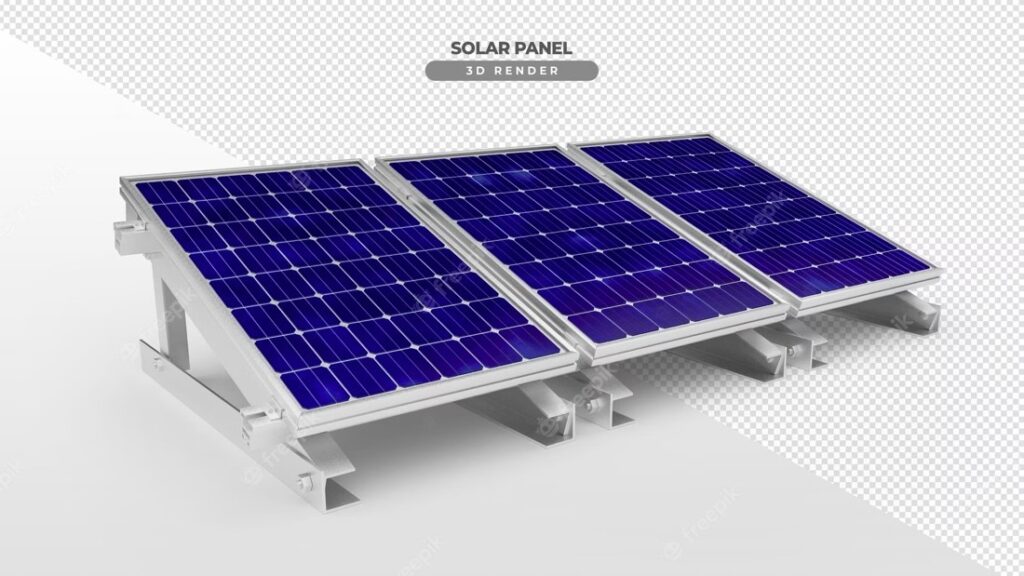
July 14, 2023
Solar panels have transformed the renewable energy sector, providing a clean and sustainable solution for power generation. With advancements in technology, the potential for increasing the efficiency of solar energy capture is growing and has become a crucial element in decreasing society’s reliance on non-renewable energy sources such as fossil fuels. During the design and installation process of solar panels, a significant amount of attention is given to factors like sunlight absorption and conversion efficiency. However, thermal conductivity in solar panels is frequently overlooked. This article explores the correlation between thermal conductivity and energy conversion efficiency and how it enhances the overall performance and extends the lifespan of solar panels.

Figure 1. Solar Power Plant
The surging demand for solar panels has revolutionized the clean energy sector by providing a sustainable, eco-friendly solution for power generation. Despite the increase in awareness and utilization of this green form of energy, the full potential of solar panels is still vastly untapped as there remains a need to enhancing the efficiency of these innovative solar cells at converting sunlight into usable energy.
The abundance of sunlight that hits the Earth in a single hour is enough to satisfy the entire global population’s energy needs for an entire year. Solar technology aims to harness and utilize the immense daily influx of energy our planet receives by converting sunlight (electromagnetic radiation) into electrical energy by employing photovoltaic panels (PV panels) or concentrated solar radiation using mirrors. This energy can be used directly at the source, stored in batteries, or transferred to other thermal storage mediums. Typically solar panels catch sunlight and convert it into useable electricity. We can use this electricity to power various solar powered lights such as power LED lights, solar powered yard lights, and solar garden lights.
PV panels are the most common form of solar energy technology that utilize solar panels and PV cells to create an electric charge that responds to the internal electrical field generated when the cell absorbs energy. This energy influx drives the flow of electrical current. Photovoltaic cells housed within solar panels are sandwiched between two layers of semiconducting materials like silicon, aluminum, or copper. Each of these layers has distinct electrical properties that depend on their thermal characteristics, including thermal conductivity. When incoming radiation (sunlight) hits these various layers, the photons become energized, creating an electrical field that generates current and electricity. Naturally, the incoming solar energy heats up the panels as photons move more energetically, generating an electrical charge. If a cell gets too warm, it can damage the solar cell and limit the efficiency of power generation.
Heat sinks and thermal material interfaces that exhibit a high thermal conductivity are installed in a solar panel to remove some of this excess heat and prevent damage to the solar panel. Heat sinks are materials such as aluminum or copper that exhibit high thermal conductivity values and can absorb heat from within the cell and dissipate it into a surrounding medium (normally air or water) by natural or forced diffusion. Thermal interface materials are normally applied in the form of a paste that is used to seal the air gap between two contacting surfaces within the multiple layers of panels in a photovoltaic cell. Air naturally has a low thermal conductivity value and can limit the amount of heat transfer within a cell putting it at risk for experiencing more damage. The thermal paste creates an improved seal, reducing excess air within a solar cell and facilitating efficient heat removal.

Figure 2. Examples of the role a heat sink and thermal interface materials have in mitigating heat transfer in solar cells. Source: https://www.researchgate.net/figure/Illustration-of-the-function-of-the-thermal-interface-materials-for-heat-removal-from-the_fig1_317395507
Thermal conductivity refers to a material’s ability to transfer heat without undergoing physical movement. The temperature of the material influences thermal conductivity, and it can also be affected by pressure, depending on the material’s intrinsic state. Normally measured in W/(m/K), thermal conductivity represents one of the three main methods of heat transfer with the other two being convection and radiation. Materials like metals or minerals are good conductors. In contrast, poor conducting materials, also known as insulators, include foam, fabrics, or substances with high levels of porosity or air. As mentioned earlier, widely used metals such as aluminum and copper, with thermal conductivity values of 237 W/(m/K) and 400 W/(m/K) respectively, are employed as thermal interface materials to enhance heat transfer away from thermally sensitive solar panel cells.

Figure 3. Example of a solar panel that is on an aluminum base to facilitate effective heat transfer.
Hotspots and concentrated areas of increased thermal energy are common issues in solar panels, but they can be significantly mitigated by incorporating high thermal conductivity materials like thermal interface materials (TMIs) and heatsinks Such localized regions of elevated temperature can significantly decrease the panel’s output and potentially lead to irreversible damage to the cell’s interior. Incorporating materials with high thermal conductivity facilitates the dissipation of these high-temperature regions, reducing strain on the panels.
Most solar panels are installed in open fields or on commercial building roofs, exposing them to various environmental conditions, such as temperature fluctuations and extreme weather events Incorporating materials with higher thermal conductivity in a solar cell enables the panel to withstand extreme temperature fluctuations over an extended period without sustaining damage or experiencing accelerated wear and tear.

Figure 4. Example of solar panels installed on the roof of a home for power collection and generation.
Solar panel technology is poised to play a pivotal role in transforming the global power generation sector into a more environmentally conscious industry, given the detrimental and irreversible effects of society’s current reliance on polluting fuels, such as natural gas, on our planet’s environment. As solar technology gains increasing traction as a widely utilized form of electricity generation, the efficiency and effectiveness of solar cells in converting sunlight into usable and distributable electricity will need to be continuously refined to effectively reduce society’s dependence on environmentally damaging methods of energy harvesting. Ensuring high thermal conductivity through the use of thermal interface materials and heat sinks represents one example of improving the efficiency of solar panels and represents an area of research that requires further exploration to fully maximize the efficiency of these devices that transform solar energy.
Arshad, A., Ali, H., Yan, W.-M., Hussein, A., & Ahmadlouydarab, M. (2017). An Experimental Study of Enhanced Heat Sinks for Thermal Management using N-eicosane as Phase Change Material. Applied Thermal Engineering, 132. https://doi.org/10.1016/j.applthermaleng.2017.12.066
Gaitho, F. M., Ndiritu, F. G., Muriithi, P. M., Ngumbu, R. G., & Ngareh, J. K. (2009). Effect of thermal conductivity on the efficiency of single crystal silicon solar cell coated with an anti-reflective thin film. Solar Energy, 83(8), 1290–1293. https://doi.org/10.1016/j.solener.2009.03.003
How do solar panels generate electricity? (n.d.). Good Energy. Retrieved July 1, 2023, from https://www.goodenergy.co.uk/how-do-solar-panels-work/
How Does Solar Work? (n.d.). Energy.Gov. Retrieved July 1, 2023, from https://www.energy.gov/eere/solar/how-does-solar-work
Huang, X., Lin, Y., Alva, G., & Fang, G. (2017). Thermal properties and thermal conductivity enhancement of composite phase change materials using myristyl alcohol/metal foam for solar thermal storage. Solar Energy Materials and Solar Cells, 170, 68–76. https://doi.org/10.1016/j.solmat.2017.05.059
Saadah, M. A. (2013). Thermal Management of Solar Cells [UC Riverside]. https://escholarship.org/uc/item/74t3m0b1
Solar Calculator. (2011, December 28). http://www.solarcontact.com/solar-calculator
Solar thermal energy. (2022). In Wikipedia. https://en.wikipedia.org/w/index.php?title=Solar_thermal_energy&oldid=1099932561
The Environmental Benefits Of Solar | EnergySage. (n.d.). Retrieved August 5, 2022, from https://www.energysage.com/solar/benefits-of-solar/environmental-benefits-solar/
What is Thermal Conductivity?. (n.d.). Thermtest. Retrieved June 23, 2023, from https://thermtest.com/what-is-thermal-conductivity